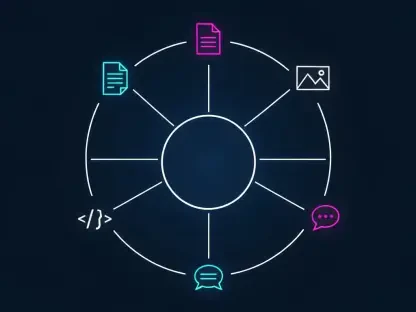Kubernetes has revolutionized artificial intelligence (AI) deployment, carving out an essential role in cloud-native computing. As AI technologies continue to evolve at breakneck speed, Kubernetes provides the innovative scaffolding needed to support them, especially on platforms like Google Cloud. This transformation is not merely about adding another layer of technology but about redefining how businesses manage, deploy, and scale AI applications. Kubernetes, originally conceived as a tool for developers, has transcended its initial purpose, becoming integral to modern IT landscapes that prioritize agility, scalability, and efficiency. Google Cloud’s strategic focus on Kubernetes exemplifies a shift toward dynamic, containerized infrastructures that cater to the growing complexity of AI workloads. As companies look for solutions to manage extensive datasets and sophisticated machine learning models, the integration of Kubernetes with AI is proving to be an indispensable asset.
Harnessing AI with Google Kubernetes Engine
Google Kubernetes Engine (GKE) is at the forefront of streamlining AI processes, providing a robust platform where machine learning models can be trained, managed, and scaled efficiently. AI development demands infrastructure capable of handling large volumes of data, ensuring precise model versioning, and executing compute-intensive tasks with ease. GKE seamlessly integrates these requirements, enhancing developers’ ability to iterate rapidly and deploy models at scale. This capability is pivotal for applications across various domains, lending itself to both specialized models and complex, large-scale projects like language models tasked with text recognition and generation. Containers, which encapsulate code and its dependencies, are at the heart of this transition. By offering portability, they eliminate platform-specific compatibility issues and accelerate deployment, facilitating AI teams as they adapt swiftly to changing conditions.
The convergence of pre-trained intelligence and open-source models marks another significant trend, simplifying AI deployment to unprecedented levels. The inference process, whereby trained models apply insights to new data sets, is now deemed as important as initial training phases. This paradigm shift underscores an era where businesses can bypass exhaustive training cycles by leveraging application programming interfaces (APIs) to incorporate AI functionalities instantly. The ability to focus on deployment nuances rather than starting from scratch enhances development speed, delivering compelling applications that leverage AI’s transformative potential. GKE’s integration with these modern approaches further augments the way organizations perceive AI’s role in contemporary settings.
Streamlining Operations with Kubernetes Automation
Beyond its capabilities in handling AI, Kubernetes shines in the arena of automation, particularly with tools like GKE Autopilot. Google’s investment in enhancing Kubernetes underscores its commitment to creating ecosystems where complexity is abstracted, allowing enterprises to dedicate more resources to actual application development. Autopilot redefines the traditional approach of configuring Kubernetes clusters manually, managing operations autonomously to optimize workflows. This strategic tool means that companies can shift their focus from infrastructure entanglement to deploying innovative products. GKE Autopilot exemplifies a forward-thinking approach where automated orchestration balances workloads effectively, enhancing resource efficiencies with minimal oversight. As a result, this automation fosters an environment where technological innovations are birthed unhindered by operational barriers.
Moreover, this advancement elevates organizations’ capabilities to accommodate unpredictable shifts in demand, particularly useful when deploying AI in live environments. Kubernetes automation isn’t just about streamlining processes; it’s about aligning infrastructure capabilities with real-world needs. Enterprises leveraging Google Cloud’s automated services gain a competitive advantage, responding dynamically to fluctuating customer requirements. GKE’s automation essentially democratizes AI technology, reducing entry barriers so that businesses, irrespective of size, can leverage advanced models. The ability to deploy robust solutions without a hefty infrastructure burden allows any entity to innovate rapidly, propelling them forward in a technology-driven marketplace.
The Role of Containerization in Reshaping Cloud Architecture
Containerization has radically reshaped cloud architecture, transforming it from traditional server-based structures to virtualized infrastructures characterized by agility and adaptability. At the heart of this revolution lies Kubernetes, fundamentally altering the manner in which applications are developed, tested, and deployed. Containers are portable units that package codes alongside their dependencies, sidestepping platform-specific constraints and facilitating seamless application integration across different environments. Initially, despite their utility, containers presented challenges until Docker simplified their use, paving the way for Kubernetes to emerge as the standard for orchestration, overseeing complex and distributed systems effortlessly.
Google Cloud has embraced these transformative changes, optimizing services like Google Cloud Run to enhance portability within serverless pricing models. This emphasis on maximizing container efficiency allows for superior deployment of AI tasks, especially crucial for inference models meant to cope with unpredictable usage fluctuations. Such advances translate to substantial cost savings and operational efficiencies, granting businesses the ability to leverage AI without being shackled by hardware or infrastructural limitations. Serverless inference models are pivotal in shaping real-time deployment strategies, particularly for sectors that must contend with variable traffic spikes. Kubernetes, as employed by Google Cloud, facilitates this flexibility, redefining how enterprises engage with cloud technologies and implement AI-driven applications within their ecosystems.
Overcoming Challenges and Innovations in Kubernetes
As Kubernetes continues its transformative journey, the challenges it addresses are not immediately visible. One remarkable innovation lies in its dynamic resource allocation capabilities, a development spearheaded by Google’s efforts to augment Kubernetes’ intelligent resource management. This underlying enhancement empowers Kubernetes to become an exceptionally astute platform, capable of supporting sophisticated hardware optimizations alongside automated resource management. By reducing human intervention, it significantly lightens the operational load on organizations, promoting a smarter allocation of computing resources that resonate with the demands of AI workloads.
Kubernetes’ evolving nature shines a light on its potential to enact changes that go beyond mere technological advancements. It embodies a shared ethos of collective responsibility and mutual benefit within the broader tech community. Google’s involvement with Kubernetes not only reflects a technical breakthrough but fosters collaboration, enabling businesses and developers to coalesce around shared objectives. This collective spirit is indispensable as AI continues to extend its influence, altering entire industries and everyday functions. Platforms like Google Cloud exemplify the unifying power of Kubernetes, nurturing collaborations that propel technological innovation into uncharted territories.
Collaborative Spirit and Future Considerations
Google Kubernetes Engine (GKE) is revolutionizing AI development by offering a powerful platform for efficiently training, managing, and scaling machine learning models. The creation of AI demands infrastructure that can handle immense data volumes, ensure precise versioning, and manage compute-heavy tasks seamlessly. GKE fulfills these needs, allowing developers to iterate quickly and deploy models at scale. This feature is crucial for diverse applications, supporting both niche models and expansive projects like language models used for text recognition and production. Central to this evolution are containers, which encapsulate code and dependencies to provide portability, eliminating platform-specific compatibility issues. This ensures rapid deployment and adaptation to changing conditions, aiding AI teams significantly.
The blending of pre-trained and open-source models is a noteworthy trend, making AI deployment simpler than ever. The inference process—where models apply discovered insights to new data—is now as vital as the initial training. This shift allows businesses to bypass lengthy training cycles by using APIs to instantly incorporate AI capabilities. Focusing on deployment nuances enhances development speed, producing impactful applications harnessing AI’s profound potential. GKE’s integration with these modern methods further shifts how organizations view AI’s role today, making it a game-changer in the contemporary tech landscape.









